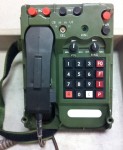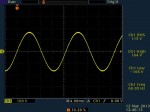
The TA-1042A/U is a member of the family of Digital Nonsecure Voice Terminals (DNVTs). Basically, this is a field telephone with a 4-wire digital interface to automatic telephone exchanges of the TRI-TAC family. The wireline interface can operate at either 16 or 32 kilobits per second. There is no embedded cryptographic capability, hence the term “nonsecure”.
Two TA-1042A/U field phones may be connected together with 4-wire field line (generally WF-16/U) and operated as plain field telephones, with power supplied by local batteries connected to the terminals on the right side of each phone. They may also be connected to a digital telephone exchange, and receive their power from the exchange over the 4-wire interface. They are not compatible with analog telephone lines, analog field phones, or civilian telephone exchanges. Earlier members of the DNVT family, such as the TA-954/TT, cannot be used without connection to a compatible telephone exchange (i.e., they can’t be used as simple field phones.
Chris Story K6RWJ and I have decided to take on a project to reverse-engineer the digital interface used by these telephones, and create an interface which will allow them to be used as VoIP phones. We have dubbed the project DNVT2IP.











